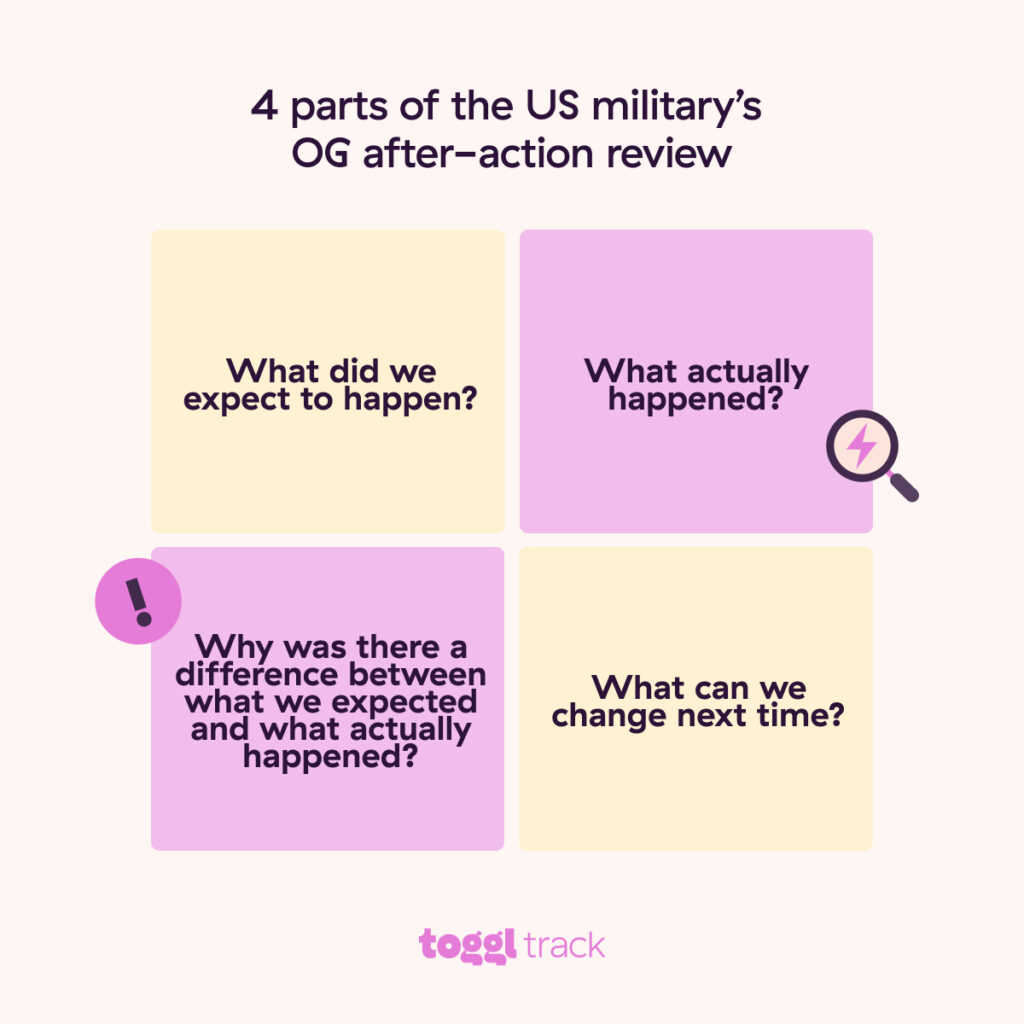One of the workplace’s most innovative review processes originated in an unlikely place: the U.S. Army.
While after-action reviews (AARs) have been tweaked to make them more applicable to project management, team evaluations, and organizational learning, we still believe the process can be modernized even more.
At Toggl, we believe there’s a better approach, and that’s why we’ve tried to modernize the traditional version of after-action reviews. Follow along as we explain the four phases of this review methodology and how you can adopt it in your organization.
TL;DR — Key Takeaways
- AARs originated in the U.S. Army in the ‘70s, but the business world has adapted them to more modern use cases.
- An AAR’s four phases are design, prepare, implement, and disseminate.
- AARs benefit organizations in numerous ways, such as promoting transparency, improving collaboration, and preventing project scope creep.
- We think the AAR can be modernized even further by focusing on data and making attendance mandatory for key participants.
What is an after-action review?
An AAR is a structured process for evaluating the success of a project, task, or event. Originating in the 1970s with the U.S. Army, AARs were introduced to replace traditional, top-down performance reviews. The process focused on reflecting on soldiers’ mistakes and achievements so these learnings could shape their future performance.
Even though their roots are in the military, AARs have sprouted up across every industry, from business to education to finance. The European Centre for Disease Prevention and Control even conducted AARs of the public health response to COVID-19.
Why? Because AARs welcome participatory communication with a narrative-driven approach. Rather than honing in on specific failures or successes, they allow teams to collaborate and analyze the history of the action or event they’re reviewing.
This approach replaces any nasty feelings of resentment with a sense of continuous improvement and optimism. That’s something any organization can get behind.
An effective AAR focuses on three points:
- What went well
- What didn’t go well
- What can we learn to improve future team performance
The four parts of the after-action review process
The military’s OG AAR — whether an informal AAR or a formal AAR — had four questions that formed the foundation of the entire process:
- What did we expect to happen?
- What actually happened?
- Why was there a difference between what we expected and what actually happened?
- What can we change next time?

In our modern usage, we can break the AAR process down into four parts:
Design
The design step in the AAR process involves creating a structured plan and setting some ground rules. In this phase, you’ll focus on key topics like goals, participants, and desired outcomes. To do so, it’s vital to outline the scope of the review and establish how it will align with your team or organizational objectives.
Outlining the scope of the review sets clear boundaries and expectations for the AAR discussion, keeping it focused and relevant. You don’t want your discussion veering off track or your team members showing up unprepared. A solid design step sets you up to gain more productive and actionable recommendations at the end of the process. Plus, you can tweak the process so it fits your team like a glove.
I love that the AAR has not become bureaucratized; we use it in different ways to fit our needs. Some AARs last only 10 minutes; others come at scheduled times during major marketing initiatives, with notes recorded and disseminated throughout our division. No complicated achievement levels to track, software to update, or lengthy courses to complete.
Pratt & Whitney President Military Engines Matthew Bromberg
Prepare
Next, gather data, identify stakeholders, and set up the logistics for the review. This includes using helpful tools to consolidate relevant project information — like meeting notes, project reports, performance metrics, etc.
If you slack on this step, you will leave room for ambiguity, derail discussions, and negatively impact your decision-making.
Implement
Your AAR discussion officially begins in the implementation step. To conduct AARs successfully, you might need a third-party facilitator (like the military) or even a note-taker. This encourages all participants to share their perspectives and have a truly open discussion.
The conversation should cover key points similar to the Army’s AAR discussion: what was supposed to happen, what actually happened, and how to improve next time. Don’t play the blame game here; otherwise, your team won’t feel fully safe and encouraged to contribute honestly.
Disseminate
In this final phase, you’ll develop an after-action report that summarizes your key findings, actionable insights, and recommendations from the review. Share this with relevant stakeholders and reference it in future projects. You don’t want to lose any insights from your discussion because they’ll act as a roadmap for implementing changes.
A tool like Toggl Track delivers extra value in this final part. It tracks insights efficiently and monitors the impact of the changes you decide to implement so you can follow up on how successful your AARs are.
4 benefits of AARs in project management
Adopting a military-inspired approach in your organization might initially scare you. Is it too rigid? Will your team shy away, worried that any response other than “Yes ma’am” or “Yes sir” will result in corrective actions? We promise that’s not the case.
AARs are hugely effective in project management, with plenty of real-world benefits. Consistent AARs will boost your project efficiency and team morale so you can operate efficiently and effectively as a structured military unit. Here’s why:
AARs promote transparency
AARs encourage everyone to voice their opinions and concerns in a structured way. Open-ended questions can encourage quieter participants and keep the insights and perspectives flowing.
No mind-reading is required — everyone stays on the same page to deliver the transparency your business needs to thrive.
AARs improve team communication
AARs create a no-blame environment where everyone feels heard. It’s a chance for your team members to speak up and be heard equally. When they see you’re valuing and acting upon their input, it builds trust.
The AAR has become a verb! We try to listen to each other, share ideas and, as a result, have become a much more cohesive and democratic group. Our employees have a voice, hold themselves accountable, and love working here.
Morgan Stanley Managing Director Ben Firestein
AARs identify actionable lessons
AARs help you identify actionable lessons by zeroing in on the root cause of what worked and what didn’t. You can pinpoint any specific challenges that arose during the project, all while capturing diverse perspectives from the entire team. Everyone agrees on the main takeaways and next steps, driving a culture of continuous improvement. The key is these lessons are specific and applicable to future projects.
AARs prevent scope creep
It’s important to focus on what really matters. But it’s still easy to get off track. AARs force you to reflect on your project outcomes, which identifies any deviations from the original action plan. Going forward, you can learn from your AARs to keep everyone aligned with the project’s core objectives — and minimize unnecessary changes that derail your project’s progress.
A better, modern approach to the AAR process
While AARs have long been a staple for capturing valuable insights, the modern workplace demands a more evolved approach to keep up with the complexity and speed of today’s projects.
Adapting the AAR process means diving deeper to uncover nuanced insights, zeroing in on the factors that truly drive success or failure, and listening to every critical voice. Our more modern twist keeps project teams agile, informed, and ready to continue improving.
Focus on the why behind change
Don’t just settle for surface-level observations — dig into the why behind your successes and failures. To reach smart, informed decision-making, you need to understand the underlying reasons that led to the outcome. This deeper analysis is the only way you can mine truly rich insights to apply to your future projects.
Spend most of your time on what actually happened
Spend the bulk of your time reviewing what actually happened rather than hypothetical situations or endless speculation. This is how you’ll extract meaningful lessons — by relying on concrete data points and real examples to guide your discussions.
Top Tip: Speaking of data, here’s a good spot to incorporate some tooling. Use Toggl Track to collect data during your projects for precise and easy reviews during your discussions.
Make participation mandatory (for key people)
A holistic review requires participation from all your key team members. Missing voices might lead to incomplete debriefs and missed opportunities for growth, which defeats the purpose of your AAR. Make attendance compulsory for those directly involved so you can ensure the necessary perspectives are heard and ultimately identify all the areas for improvement.
Make better decisions with the right tools
You might know all the steps of your AAR like the back of your hand, but using the right toolkit will elevate each AAR process phase. Toggl Track centralizes your data, tracks performance trends, and simplifies reporting.
Tools with functionality for tracking time, managing budgets, and analyzing outcomes help team leaders organize the review process and enable you to apply those all-important lessons learned. Make your AAR process even more impactful and actionable by trying Toggl Track for free.
Track performance trends to make better decisions
Toggl Track is a user-friendly time tracking tool that gives you powerful time data insights to optimize productivity and profitability.
Michelle is an experienced freelance writer who loves applying research and creative storytelling to the content she creates. She writes about B2B SaaS software while also participating in conversations about other industries, such as the digital publishing landscape, sports, and travel.





